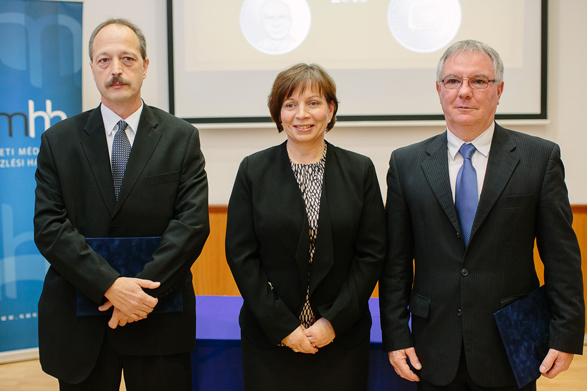The World in Living Colour: The Carl Peter Goldmark Goldmark Award
Inaugural award ceremony: Head of Hungarian National Media and Infocommunications Authority presented the Carl Peter Goldmark Award for the first time
nullThe inaugural Carl Peter Goldmark Award was handed out on October 16 to Mr. Menyhért Dobos, Head of Duna Media Services, (Duna Médiaszolgáltató) and Mr. András Mádl, Head of the NMHH Department of Programme Monitoring. The Award was founded by the president of the Hungarian National and Media Authority (NMHH) in 2014 to honour a lifetime achievement in professional excellence, outstanding accomplishments in broadcasting and media services.

“Today’s dedicated professionals are tomorrow’s Carl Peter Goldmarks. They are today’s outstanding co-workers involved in today’s media, engendering no lesser advancement than colour television had been in their time. Progress is at a far greater clip these days, and it is easier to overlook fantastic accomplishments. So it is pivotal, I believe, that we acknowledge and spotlight excellence of accomplishment,” highlighted NMHH president Mónika Karas at the inaugural Carl Peter Goldmark Award ceremony. The memorial medallion is handed out each year on the anniversary of the Media Council’s founding back in 2011. The inaugural Carl Peter Goldmark Award went to Menyhért Dobos, Duna Television CEO (Duna Televízió Zrt.) and András Mádl, who heads the NMHH Department of Programme Monitoring, at the Authority award ceremony in Budapest.
András Mádl was born in 1961 and oversees the Hungarian National Media and Infocommunications Authority Department of Programme Monitoring and Analysis. He joined Hungary’s previous media authority in 1997 and has remained on board with the NMHH, its successor. His remit is to oversee media service providers and media services, in which he has consistently excelled. Mádl led the NMHH effort to establish the IRIS programming oversight and monitoring system. Its traits render IRIS unique even in the EU. IRIS stores information retroactively, going back as far as 1990, to the tune of some 115 terabytes of data. This exceptional system enables search for decades of programming involving 141 radio and television channels. Two countries have signalled interest in creating a similar system – a testimony to IRIS’s effectiveness. As a result, the NMHH has adapted IRIS to Malta and Cyprus as well. Credit must go to András Mádl for the state-of-the art technologies and methods with which the Authority is now able to oversee Hungary’s domestic media. Regulatory remit is not the sole beneficiary, however. As a university professor, he also shares his formidable knowledge with his students – the future generations of media professionals.
Menyhért Dobos was born in 1950 and is CEO of Duna Media Services Non-profit Plc (Duna Médiaszolgáltató Zártkörűen Működő Nonprofit Részvénytársaság). His pivotal remit: to coordinate public media operations. To date, his professional work has contributed ongoing backing to public media advancement. His career kicked off in 1969, when he joined Hungarian Television as an image and sound technician. Then came a stint as image engineer, during which he contributed to production of eighty made for TV films. Moving on, he headed the MTV customer relations department, then led its department of organisational relations. He also worked as vice president, then president of the MTV Chair’s inner executive circle. In the 1990s, he served as president of the MTV Civil Servant Council, which he co-founded, and as president of the Television Producers Advocacy organisation. He graduated from Janus Pannonius University’s Faculty of Liberal Arts in 1997. In the early 2000s, he worked at the MTV Public Affairs Editorial Offices, subsequently appointed M1 and M2’s acting director of programming and deputy director general of services. Dobos was Duna TV CEO from 2011 until his current assignment.
Carl Peter Goldmark (in Hungarian: Péter Károly Goldmark, 1906–1977) – Father of colour TV
Inventor and engineer. Born in Budapest, he adopted his middle name Károly in honour of his uncle, Károly Goldmark, the famous composer. Coming from a family of musicians, Goldmark was musically talented himself, even played together with Benny Goodman. He pursued his studies in Vienna and Berlin. He also worked with Nobel laureate Denis Gábor (Dénes Gábor). Back in Vienna, Goldmark worked on developing electronic picture tube television and imaging. On his 20th birthday in 1926 he put together a device, on the very small screen (2.5x3.8 cm) of which he succeeded to create a picture. He moved to the United States in 1933, where he joined the CBS as chief television engineer. When CBS created its CBS Laboratories division in 1951 Goldmark was named its head. In 1940 he created the first television colourcast and the first colour TV set. During the Second World War he invented several systems for jamming German enemy radar. In the post-war years he worked on perfecting colour television technology. Goldmark’s numerous other inventions included the long-playing microgroove phonograph record (LP), the EVR (Electronic Video Recorder), the Highway HiFi, use of television in medical technology, as well as the mini-TV in the diagnostic tests for the stomach and intestinal system. The Apollo-10 moon expedition used the mini colour lunar surface TV camera he created. In 1977, the year he died, President Jimmy Carter presented Goldmark with the illustrious National Medal of Science for his life work.
Recognition for telecommunications professionals:
Besides the Carl Peter Goldmark Award, the NMHH president, has also founded the Endre Magyari Award to honour professionals in the telecommunications field for an achievement in excellence. In May 2015, this award went to István Bartolits, Head of the NMHH Department of Technology Analysis, and to telecommunications expert Károly Fiala.